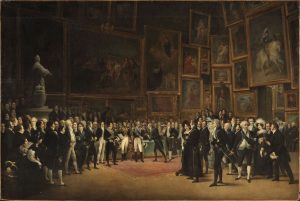Call for Articles: New Perspectives on the Arts in the Salon 1815–1850
Editors: Anja Bunzel, Natasha Loges, Melanie Unseld
Deadline for expressions of interest: 28 February 2023
Nineteenth-century European salon culture has received attention regarding its socio-cultural impact and musical performance practices, particularly in cities like Berlin, Vienna, Paris, and Weimar. In general terms, salons were regular social gatherings in private and semi-private spaces. Their frequency, size, reach and cultural focuses could vary greatly, depending on many factors, including: the affinities, tastes, and financial means of the individual hosts and guests; local cultural, economic, and political infrastructures; and wider current events. Nevertheless, salons frequently nurtured an artistic element, alongside the more general aims of entertainment, intellectual exchange and socio-cultural mediation through conversation and networking. These artistic activities could comprise, for instance, the creation of music, poetry, longer literary genres, or drama, tableaux vivants, paintings, drawings, or other crafts.
Moreover, it is often claimed that salons offered more creative, social, and intellectual agency to women, who were otherwise largely excluded from public life. More recently, it has been argued that the artistic outputs of salons had much to offer in the way of compositional and technical diversity, creative wit and inspiration, and historical snapshots. These might include musical and literary greetings in personal autograph albums, collaborative works; dedications; occasional compositions, literature, or paintings commemorating specific events and/or personal experiences; caricatures of scenes or people.
Viewing salon culture through the lens of artistic collaboration and/or output may help to re-evaluate the significance and historiographical potential the salon. This approach also calls into question such common historiographical binaries as „public vs private“, „professionalism vs. amateurism“, „planned agenda vs. spontaneity“, „one form of art vs. works and performances involving more than one art“, „long/complex vs. short/simple genres“, „student vs. teacher“, „male vs. female domains“, „high class and social status vs. low class and social status“, and many more.
The proposed special-themed issue encourages the re-evaluation of the artistic output of the salon as a cross-artistic and socio-culturally multi-layered phenomenon.
Themes may include:
– musical, literary, artistic, scientific, architectural etc. artefacts and outputs originating in salon culture, especially intermedial/cross-arts outputs
– activities and practices associated with salon culture (e.g. dance; musical, literary, dramatic performance; games, puzzles, riddles; joint ad-hoc works like jokes, rhyme, short stories, canons; crafts etc.);
– reception of salon culture in its own time (for instance, through published materials or in (auto)biographical documents) and its impact on other art forms (for instance, literary farce and irony, caricatures, musical jokes and paraphrases);
– salon culture, the historical sources surrounding it, and its artistic repertoire through the lens of wider cultural-historical concepts (for instance, canon formation, genre, commemoration studies).
The editors particularly welcome interdisciplinary explorations and/or studies which encourage a re-evaluation of established historiographical categories, during the period 1815–50.
Please send first expressions of interest to the coordinator, Anja Bunzel (Institute of Art History, Czech Academy of Sciences) at bunzel@udu.cas.cz by 28 February 2023.
Source : https://arthist.net/archive/38511


Leave a Reply
You must be logged in to post a comment.